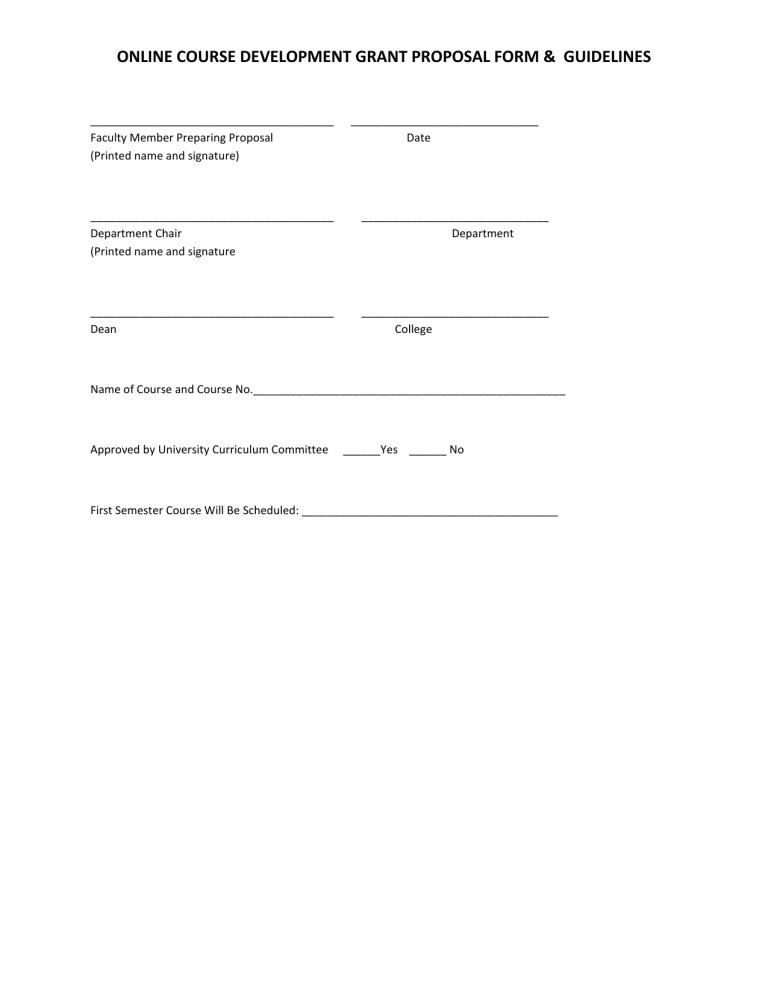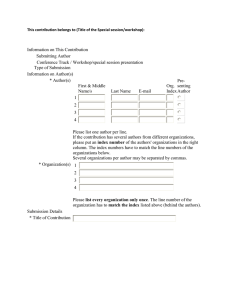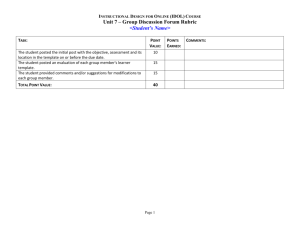To be eligible for new online course development grants being

ONLINE COURSE DEVELOPMENT GRANT PROPOSAL FORM & GUIDELINES
_______________________________________ ______________________________
Faculty Member Preparing Proposal Date
(Printed name and signature)
_______________________________________
Department Chair
(Printed name and signature
______________________________
Department
_______________________________________ ______________________________
Dean College
Name of Course and Course No.__________________________________________________
Approved by University Curriculum Committee ______Yes ______ No
First Semester Course Will Be Scheduled: _________________________________________
One requirement for eligibility for new online course development grants being offered in Spring 2011
is adherence to the following schedule and submission of the following deliverables. Grant payment will be dependent on adherence to this schedule and on online course design and development approval by the Columbus State University Distance Learning Committee as described below.
The following schedule and submission processes have been created to promote quality and consistency across online courses offered at Columbus State University. Online courses at Columbus State
University should:
Employ best practices for online course design and delivery based on research
Model a consistent look and feel with content organized by learning modules
To address these criteria, Distance Learning Design & Delivery (DLDD) has developed a CougarView template as a starting point for course design. The template has a pre-designed structure that expedites course development and embodies pedagogical best practices for online courses. The template also provides a consistent overall look and feel for students. We highly recommend that you use this template in your course design.
1. February 10 – March 4: Review the Addressing Quality Matters Rubric Standards through DLDD-CSU
Services, Tools and Resources document and embedded links which have been selected to help you address the Standards of the Quality Matters (QM) Rubric. The document maps key services, tools and resources provided by Distance Learning Design & Delivery (DLDD) and Columbus State University (CSU) to QM Rubric Standards. Note that additional resources to help meet QM Rubric Standards are provided in the Resources section of the DLDD web site at http://dl.columbusstate.edu/resources.php
.
Consider attending a CougarView Template Workshop to be scheduled in late February, 2011.
2. March 7-18: Submit your QM action plan along with requisite grant forms to the Distance Learning
Committee Chairperson, Jackie Radebaugh (radebaugh_jacqueline@colstate.edu). Your plan needs to clearly specify how you will address each of the Standards of the QM Rubric. Your plan should describe in detail how you will utilize key DLDD-CSU services, tools and resources in the design, development and delivery of your new online course.
3. March 28-April 8: Schedule an online course design and development initial meeting consultation with DLDD staff. Contact information is provided at: http://dl.columbusstate.edu/staff.php
. Marty
Westrick and Wayne Slabon will review your QM action plan and provide you with design and development recommendations. You will also be given a sandbox area in CougarVIEW for course development. Note that your first two course modules, a course overview/introduction module and a
first unit of instruction module, need to be fully developed for presentation between May 23 and June
3. The CougarView template available from DLDD can greatly assist you in developing the first module.
4. April 18-29: Schedule an online course design and development checkpoint 1 consultation meeting with DLDD staff.
5. May 9-20: Schedule an online course design and development checkpoint 2 consultation meeting with DLDD staff.
6. May 23-June 3: Advise the Distance Learning Committee Chairperson, Jackie Radebaugh
( radebaugh_jacqueline@colstate.edu
) that you have completed development of your first two course
modules and would like to schedule a presentation. For scheduling purposes, please provide a few date and time options. The Distance Learning Committee Chairperson will then notify you of a suitable presentation date/time. You will present your first two course modules to the Distance Learning
Committee for consideration with the QM Rubric as the instrument for online course design and development evaluation.
This presentation will allow you to receive and give peer-to-peer feedback. For instructors not on campus during this time, a Wimba session may be scheduled for the presentation.
7. June 7: Notifications will be sent to candidates of online course design and development acceptance or the specification of necessary revisions before approval can be granted. If course revisions are necessary, you will have two weeks, until June 21, to make and present the requisite revisions to the
Distance Learning Committee Chair and still be eligible for June 2011 grant fund disbursement. If you are unable to make the requisite revisions by the June 21 deadline, you will no longer be eligible for June
2011 funds disbursement. However, you may continue working on your course design and development and re-submit for future grant consideration, predicated on grant funding availability.
If you should have any questions, please contact the Distance Learning Committee Chairperson, Jackie
Radebaugh, at 706.565.3555 or radebaugh_jacqueline@colstate.edu
.
Addressing Quality Matters Rubric Standards through DLDD-CSU Services, Tools and Resources
Quality Matters Rubric Standards
Course Overview/Intro
Get started instructions
Course purpose /components statement
Etiquette
Instructor self-introduction
Student introductions
Prerequisite domain knowledge
Minimum tech skills expected
Learning Objectives
Measurable course outcomes
Module/unit objectives are measurable and consistent w/course objectives
Clearly stated from students’ perspective
Clearly stated instructions for accomplishing objectives
Appropriate for course level
Assessment & Measurement
Assessments measure objectives and align with course activities and resources
Course grading policy clearly stated
Evaluation criteria for participation and deliverables provided
Sequenced, varied, and content-appropriate assessment instruments
Practice assignments w/timely feedback
Resources & Materials
Contribute to course/unit objectives
Clearly explained relationship of course materialslearning activities
Materials are of sufficient breadth, depth, and currency
Appropriately cited resources/materials
DLDD-CSU
Services, Tools & Resources
DLDD Consultation Services
DLDD Template
DLDD Workshops
Instructional Technology Guides/Tutorials
Snagit annotated images
Camtasia, Captivate, Jing, Tegrity, or Wimba demonstrations
DLDD Site Resources :
Icebreaker Overview
Icebreaker Techniques
DLDD Consultation Services
DLDD Site Resources :
Bloom's Taxonomy
Bloom's Revised Taxonomy
Revised Taxonomy Article
Learning Objectives
Learning Objectives
DLDD Consultation Services
DLDD Site Resources :
Assessment
Course Alignment
Discussion Board Rubric
Discussion Board Rubric
DLDD Workshops
Instructional Technology Guides/Tutorials
CougarVIEW assessments
Respondus assessment creator
StudyMate gaming reinforcement
DLDD Consultation Services
DLDD Workshops
Instructional Technology Guides/Tutorials
Tegrity lecture capture
Wimba virtual classroom
Snagit annotated images
Camtasia demonstrations and lecture capture
Captivate demonstrations, simulations, and branching
LMS integration of additional resources
(e.g., third-party materials)
CSU Distance Learning Library Resources
Quality Matters Rubric Standards
Learner Engagement
Activities promote achievement of objectives
Activities foster interaction (I-S, C-S, S-S)
Clear standards for responsiveness
Clear requirements for interaction
Course Technology
Appropriately deliver content and support
objectives
Support engagement and guide active learning
Logical, consistent, and efficient navigation
Readily accessible
Course components compatible w/current delivery modes
Easily understood and sufficient instructions on accessing resources
Course design takes full advantage of tools
Learner Support
Tech support clearly articulated
Academic support resources explained
Student support services explained
Research, writing, tech resources provided
Accessibility
Incorporates ADA standards and institutional policy re: accessibility
Alternatives to auditory and visual content
Self-describing, meaningful links
Ensures screen readability
DLDD-CSU
Services, Tools & Resources
DLDD Consultation Services
DLDD Workshops
Wimba virtual classroom
Tegrity presentations (Student)
DLDD Site Resources
Principles of Instruction
Instructional Strategies
Collaborative Learning Strategies
Collaborative Problem Solving
Discussion Board Tips
Discussion Board Rubrics
Facilitating Online Discussions
Facilitator Strategies for Problem-
based learning
Learning Activities
Problem Based Learning
DLDD Consultation Services
DLDD Workshops
Instructional Technology Guides/Tutorials
CougarVIEW tools
Tegrity lecture capture
Wimba virtual classroom
Snagit annotated images
Camtasia demonstrations
Captivate simulations/branching
CougarVIEW assessments
Respondus assessment creator
StudyMate gaming reinforcement
Tools to Promote Learning Outcomes
DLDD Consultation Services
DLDD Template
CSU Student Help Desk
USG Online Support Center
DLDD Site Resources
Online Student Success
Characteristics
SmarterMeasure
CSU Resources for Writers
CSU Online Writing Consultation
CSU Distance Learning Library Resources
DLDD Consultation Services
DLDD Site Resources
CSU Disability Services
CSU ADA 504 Syllabus Statement
Accessible Design Guidelines
Universal Access Resources







